Venus flytraps are unique plants. They are carnivorous plants that can consume bugs. Also, their growth stages unique. In this article, I will expand on the details of Venus flytrap growth stages and their life cycle.
If you are growing a Venus flytrap, this information will give you a better understanding of how to care for them and their life cycle. Here is a short overview on what to expect
Venus flytraps take 4 to 6 weeks to sprout from seeds. They grow rapidly and reach maturity when they are 2-4 years old. After maturity, they continue growing at a slower pace and can live up to approximately 20 years.
Here is a summary of what you can expect to see year over year:
| Life Cycle Year | Overview |
| Year 1: Germination and seedlings | Venus fly traps take 4-6 weeks to germinate. Seedlings have the exact shape as adult Venus flytraps, but just very tiny. The growth accomplished in the first year is dependent on the environment, enough light and water are critical factors. |
| Year 2: Continuous Growth | By the end of year two, Venus fly traps will develop traps that expand to 1/4 of an inch or even half and inch. |
| Year 3 -4: Maturity | Venus fly traps will start producing flowers every spring and propagating through divisions. |
| Year 5-7: Maximum Size | Venus fly traps will continue to grow after maturity and reach their maximum size at year 5-7. Depending on the cultivar, Venus fly traps can develop traps as big as 1.5 – 2 inches. |
Th growth stages of a Venus flytrap can be divided into the following:
- Seed germination
- Dormancy
- Flowering/ Blooming
- Seed propagation
- Growing season
- Vegetative propagation
- Artificial propagation: leaf pullings
Keep on reading to learn more about each stage.
Seed Germination
Venus flytraps produce seeds when their flowers are pollinated. The seeds from a Venus flytrap are tiny, shiny, and black. Also, their seeds do not need stratification.
When growing Venus flytraps from seeds, attempt to germinate them as close to harvest as possible. When the seeds get older, the probability of producing seedlings lowers significantly.
To germinate Venus flytraps seeds, follow these instructions:
- Get a pot with drainage holes.
- Moisten carnivorous plant soil with distilled water, rainwater, or reverse osmosis water. If you are unfamiliar with carnivorous plant soil, read this article to find out where to buy it or how to make it. Never employ standard potting soil, as it can kill Venus flytraps. Also, make sure to employ only the pure water sources mentioned above.
- Place the humid carnivorous plant soil in the pot. Make sure the media is humid all around.
- Sow the seeds in the soil and do not bury them. Sprinkle them on top of the soil.
- Place the pot inside a transparent Ziploc bag and close it.
Then, provide the appropriate care to encourage them to germinate:
- Place the seeds under direct sunlight for more than six hours a day
- Keep the soil moist at all times, do not let it dry out
- Consider misting the seeds to increase the humidity levels
Venus flytraps seeds can take up to five weeks to germinate.
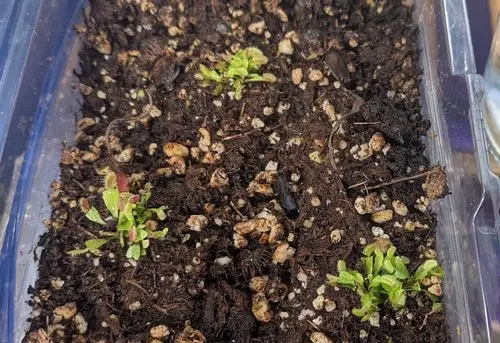
This article: Venus Flytrap Seedling Care Guide (6 Major Considerations) , can help you learn how to care for Venus flytraps seedlings once they start growing.
, can help you learn how to care for Venus flytraps seedlings once they start growing.
Venus Flytrap Dormancy
Venus flytraps require a yearly dormancy period.
In the wild, Venus flytraps are exposed to cold temperatures for several months in a row. During their winter season, Venus flytraps go dormant.
The dormancy process is similar to hibernation. The plant goes into a resting mode for several months.
During dormancy, Venus flytraps stop growing. They lose the vast majority of their leaves, if not all, and shrink in size. Sometimes their owners think their Venus flytrap is dead, but the plant is just dormant in reality.
Venus flytraps enter dormancy when they are exposed to temperatures below 45F for several weeks. The temperature must remain below 50F to keep Venus flytraps dormant. Venus flytraps experience a full dormancy after 3 to 5 months in cold climates.
Here are some care tips to keep Venus flytraps healthy during dormancy:
- Do not feed or fertilize Venus flytraps during dormancy
- Avoid letting Venus flytraps freeze during winter. Venus flytraps can withstand cold temperatures below freezing (32F), but the plant should never freeze solid.
- Avoid overwatering your plant. In the winter months, Venus flytraps tend to consume less water.
As the temperatures rise, Venus flytraps will exit dormancy. When the plant is out of inactivity, it will start exhibiting new growth, including flowers.
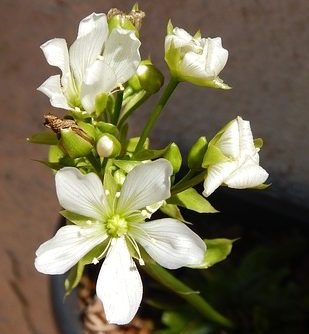
Flowering in Venus Flytraps
Mature Venus flytraps produce flowers every year during the spring. They usually produce 2-3 flower stalks which end in white flower bunches.
Not everyone is aware that Venus flytraps produce not only traps but also flowers. Sometimes Venus flytrap owners are confused by the long flower stems growing out of their plants.
Long tubular stems growing in Venus flytraps are flower stalks. Flower stalks grow tall above the traps and develop flowers. You can choose to let your Venus flytrap flower or stop the flowering process; each option has some benefits.
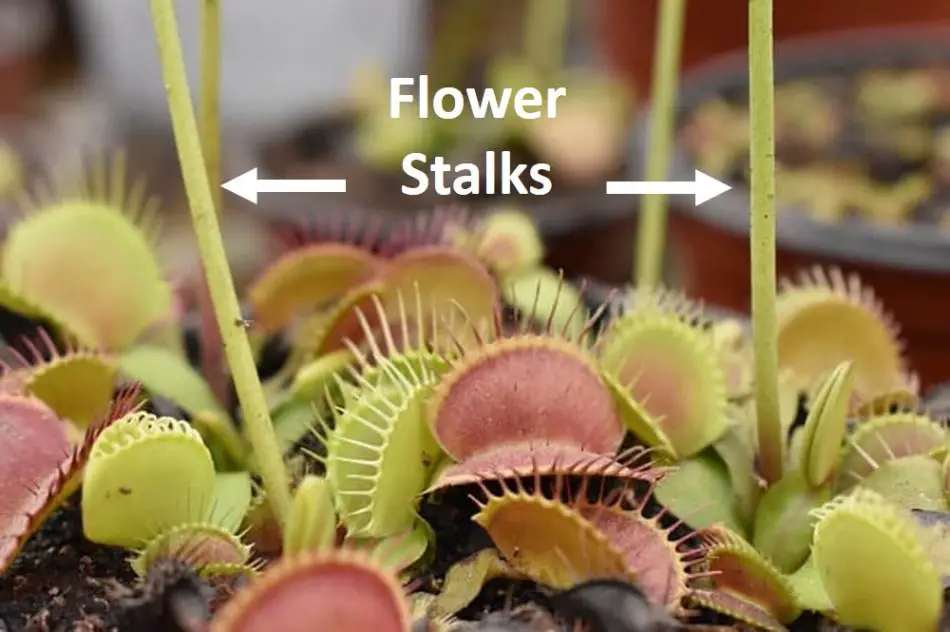
The flowers in Venus flytraps are pretty but not overly impressive. Since Venus flytraps spend a lot of energy producing flowers, many recommend stopping the flowering process by cutting the flower stalks before they develop.
Removing the flower stalks early on will save the Venus flytrap a lot of energy it can employ to grow and develop. However, if you leave the flower stalks, you can potentially pollinate the flowers and collect seeds.
You can learn more about the flowering process and what to do from this article . In most cases you will want to remove the flower stalks.
. In most cases you will want to remove the flower stalks.
There is a method to propagate Venus flytraps with flower stalks. You can learn the process in this article: Venus Flytrap Flower Stem Propagation .
.
Venus Flytrap Flower Pollination
Venus flytraps are self-pollinating. The seeds obtained through self-pollination produce similar plants to the parent but not exact clones. The other option besides self-pollination is cross-pollination. In cross-pollination, a flower is pollinated by pollen from a flower in another plant.
Here are the step by step instructions to pollinate Venus flytrap flowers:
- Let your Venus flytrap flower.
- Gather a Q-tip or a soft and small paintbrush to pollinate the flowers.
- Identify the anther and the stigma in the flowers.
- The anther holds pollen (located at the end of thin filaments)
- The stigma is located in the center of the flower
- Utilize your paintbrush or Q-tip and brush the anther. Repeat a few times to collect some pollen.
- Use your tool full of pollen and brush the stigma several times.
- Pollinate all the flowers you have to increase the probability of success.
- Fertilized flowers will dry up and leave seeds behind a few days after pollination. Each pollinated flower produces a few dozens of seeds.
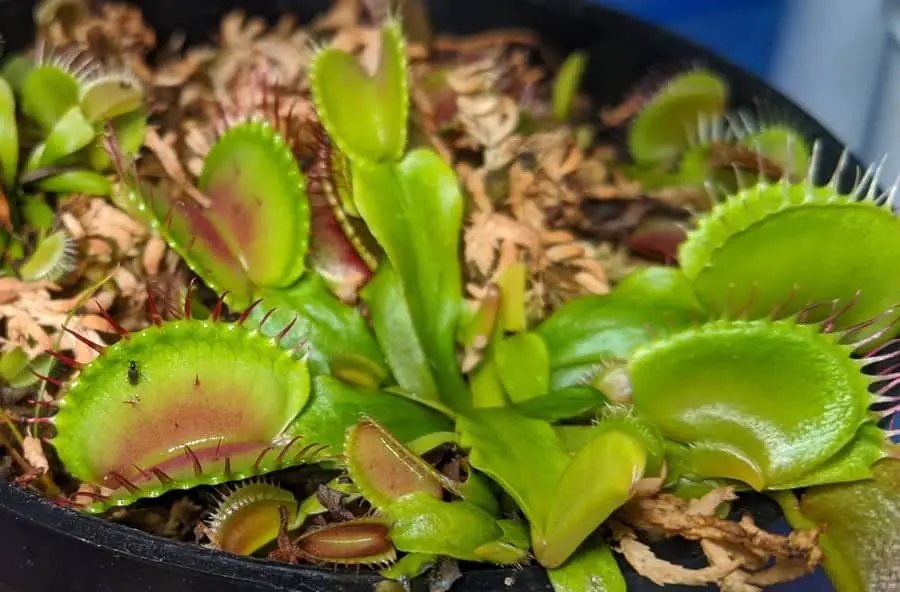
The Growing Season
Venus flytraps start the growing season in the spring and finish it when they enter dormancy. During this season, Venus flytraps grow at full speed, increasing the traps’ size and sometimes dividing into multiple plants (vegetative propagation).
How long do Venus fly traps take to grow?
On average, 3-4 years is the amount of time it takes to grow Venus flytraps from seeds until maturity. Mature plants start producing flowers and can continue growing in size if given proper care. Proper lighting, watering, and suitable soil can affect the time Venus flytraps take to reach adult size.
The sizing chart below summarizes the expected size of a Venus flytrap for several years.
| Age | Trap Size | Recommended Pot Size (diameter) |
| Seedlings | Tiny | Any size |
| 1-2 years | 1/8 inch | 2” |
| 2-3 years | 1/4 inch | 3″ |
| 3 years | 1/2 inch | 4″-5″ |
| 4+ years | 1 – 2 inches | 6″ |
Venus flytraps can also grow to maturity from leaf pullings (cuttings) or rhizome divisions. Both of those propagation methods deliver adult Venus flytraps much faster than seeds.
How can I make my Venus Fly Trap grow faster?
Extensive light exposure, a consistent amount of water, a yearly dormancy, and having access to bugs can encourage growth in Venus flytraps. Venus flytraps do not need fertilizers to grow faster; proper lighting and regular feeding ensure the plant grows rapidly.
Fertilizers can be very harmful to Venus flytraps if misused. Never attempt to employ fertilizers unless you have done your due diligence. Instead, consider feeding your plant or providing more lighting. Both of those will encourage growth.
This article gives you tips to help your Venus flytrap grow as large as they can be: 11 Tips to Grow Big Venus Flytraps (Sizing Chart Included)
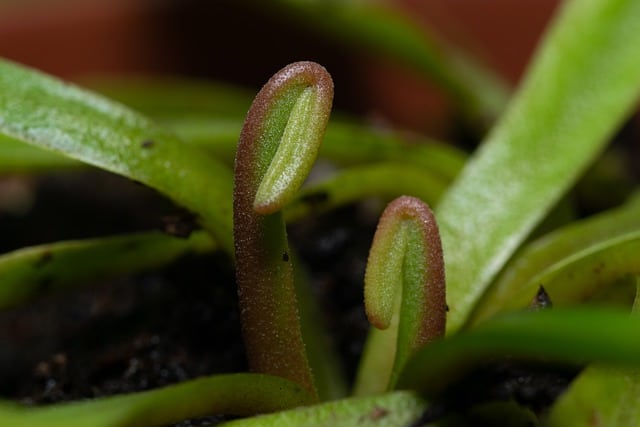
Rhizome Divisions
Venus Flytraps can reproduce via rhizome division (vegetative propagation). Vegetative propagation usually occurs during the growing season, when conditions are optimal.
Venus flytraps exhibit 3 to 7 healthy leaves at a time. Venus flytraps with multiple heads, like, for example, 15 or 20, are not a single plant. The original plant has propagated and created clones of itself through rhizome divisions.
After a Venus flytrap has propagated via rhizome, you can easily separate them and pot each plant independently. The video below shows how a single plant ended up being 7 independent flytraps.
As soon as I saw the plant below, I knew there had to be at least four independent Venus flytraps. It needed to be repotted, so I divided it.
Artificial Propagation Germination
It is possible to extract a Venus flytrap leaf from an existing plant and produce a clone. This process is called leaf cuttings.
The best time to pull leaf cuttings is during the growing season (avoid dormancy). Here is how it works, step by step.
- Remove your Venus flytrap from its pot and all the soil until it is bare-root.
- Identify a healthy leaf on the external layer of leaves
- Grab the leaf from the top and gently but firmly pull it downwards and outwards. The goal is to separate the leaf with a small portion of the rhizome in its base.
- Repeat step 3 multiple times, if desired.
- Place the leaf cuttings in moist carnivorous plant soil by laying them on their side.
- Cover the rhizome section with some of the soil.
- Wait until the seedlings spur.
It takes 1-3 months for seedlings to start growing out of leaf pullings. Once the seedlings have spurred, it only takes 2-3 years for them to reach maturity.
Venus Flytrap Care
Venus flytraps are unique plants. The list below outlines the main care considerations you should implement to keep your plant healthy.
Water: Water your plant only with pure water, such as distilled water, rainwater, or reverse osmosis water. Never employ tap water or bottled water, as it might contain high amounts of minerals that kill Venus flytraps.
Water your Venus flytraps often so that the soil remains moist but not flooded. The ground should never dry out, as Venus flytraps suffer in arid environments. Press the soil with your finger after watering, and verify the ground is moist but not saturated to avoid overwatering.
Light: Venus flytraps thrive in sunny locations. Place your Venus flytrap under bright direct sunlight for at least 6 hours a day. If possible, provide more than 10 hours of daylight; Venus flytraps thrive in sunny spots.
Venus flytraps can be grown indoors or in windowsills, but it tends to be a challenge due to their high lighting requirements. For indoor locations, employ artificial lightings such as LED or fluorescent lights of cool colors 6500K and over 1500 lumens.
Soil: Venus flytraps can’t grow in standard potting soil, they need nutrient-free, fertilizer-free potting media.
Employ carnivorous plant soil for your Venus flytrap. You can make carnivorous plant soil by combining peat moss or sphagnum moss with perlite or sand. Also, many nurseries and online retailers sell premade carnivorous plant soil.
Planting Venus flytraps in the wrong soil will kill the plant. Make sure you use carnivorous plant soil. This article teaches you how to make it and where to buy it: The Best Soil Options for Venus Flytraps .
.
Change soil once a year to avoid mineral build-up.
Dormancy: Venus flytraps need exposure to cold weather during 3-5 months to complete a dormancy period.
Venus flytraps achieve dormancy when they are exposed to temperatures below 45F for several weeks. Then, the plants should remain cold for more than three months.
Venus flytraps must go dormant every year. If they skip dormancy several years in a row, the plants will start dying.
several years in a row, the plants will start dying.
Suppose the weather does not permit your Venus flytraps to go dormant naturally. Consider employing the refrigerator dormancy method.
Feeding: Venus flytraps benefit from consuming bugs. They do not need to capture bugs, to survive, but consistent feeding can encourage growth.
Place your plant outdoors to let in consume insects on its own. For indoor plants, consider feeding it once every 3-6 weeks. Feeding your plant a single bug every month can make a big difference.
Pots: Venus flytraps have long vertical roots that grow well in tall pots.
Venus flytraps can be potted alone in smaller containers or in bundles in large pots.
Avoid employing terracotta, clay, or unglazed ceramic pots for Venus flytraps. Those materials leach minerals to the ground, and those minerals are harmful to Venus flytraps.
Select pots with drainage holes to avoid rotting issues.
Terrariums: Venus flytraps do not need terrariums to grow. Terrariums can be very harmful to Venus flytraps, as they block sunlight, restrict airflow, prevent Venus flytraps from capturing bugs, and cause rotting issues.
The only benefit from growing Venus flytraps in terrariums is the high humidity. But, high humidity can be achieved by misting regularly using a humidifier.
I hope you found this article to be useful. You can find more information on Venus flytrap care this detailed guide: Ultimate Venus Flytrap Care Guide – Free Care Sheet Included . For Venus flytraps growing indoors, this article can help you build the right setup: Venus Flytrap Indoor Care Guide
. For Venus flytraps growing indoors, this article can help you build the right setup: Venus Flytrap Indoor Care Guide .
.
Recommended Products for Carnivorous Plant Growing
- Carnivorous Plant Soil
- Carnivorous plant soil: https://amzn.to/3uVbg39

- Pure peat moss for carnivorous plants: https://amzn.to/3vTqirs

- Pure perlite: https://amzn.to/3ppckLF

- Carnivorous plant soil: https://amzn.to/3uVbg39
- Artificial Lighting
- Small plant light for 1-4 plants: https://amzn.to/2RsGlxr

- T8 LED light fixture for multiple plants (6500k Cool White): https://amzn.to/3uWoeh2

- Intelligent outlet: https://amzn.to/3fUdN9p

- Intelligent outlet: https://amzn.to/3fUdN9p
- Small plant light for 1-4 plants: https://amzn.to/2RsGlxr
- Pots
- Nursery pots for single plants: https://amzn.to/34Q6byu

- Net pots for single plants: https://amzn.to/2TMqgDJ

- Nursery pots for single plants: https://amzn.to/34Q6byu
